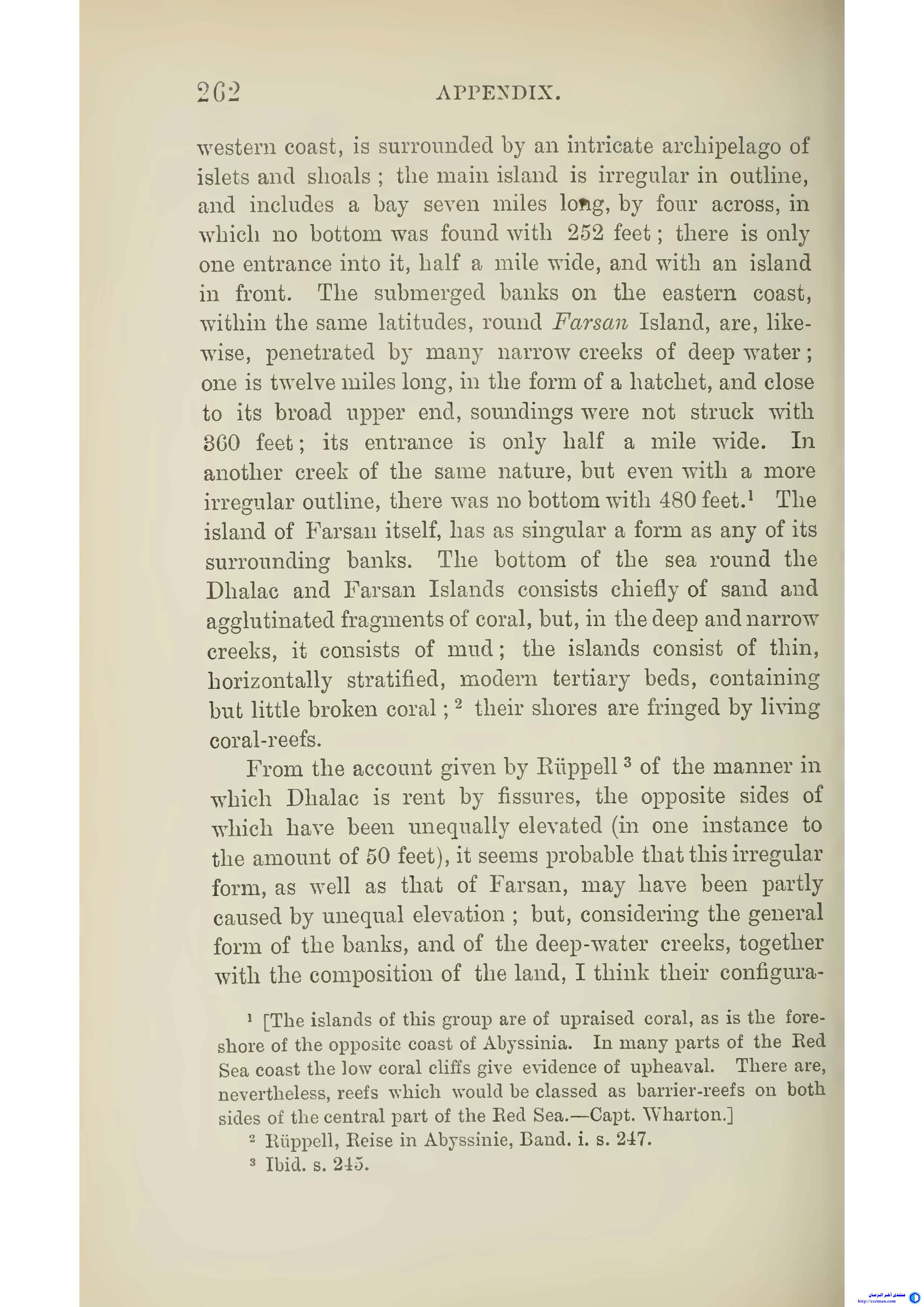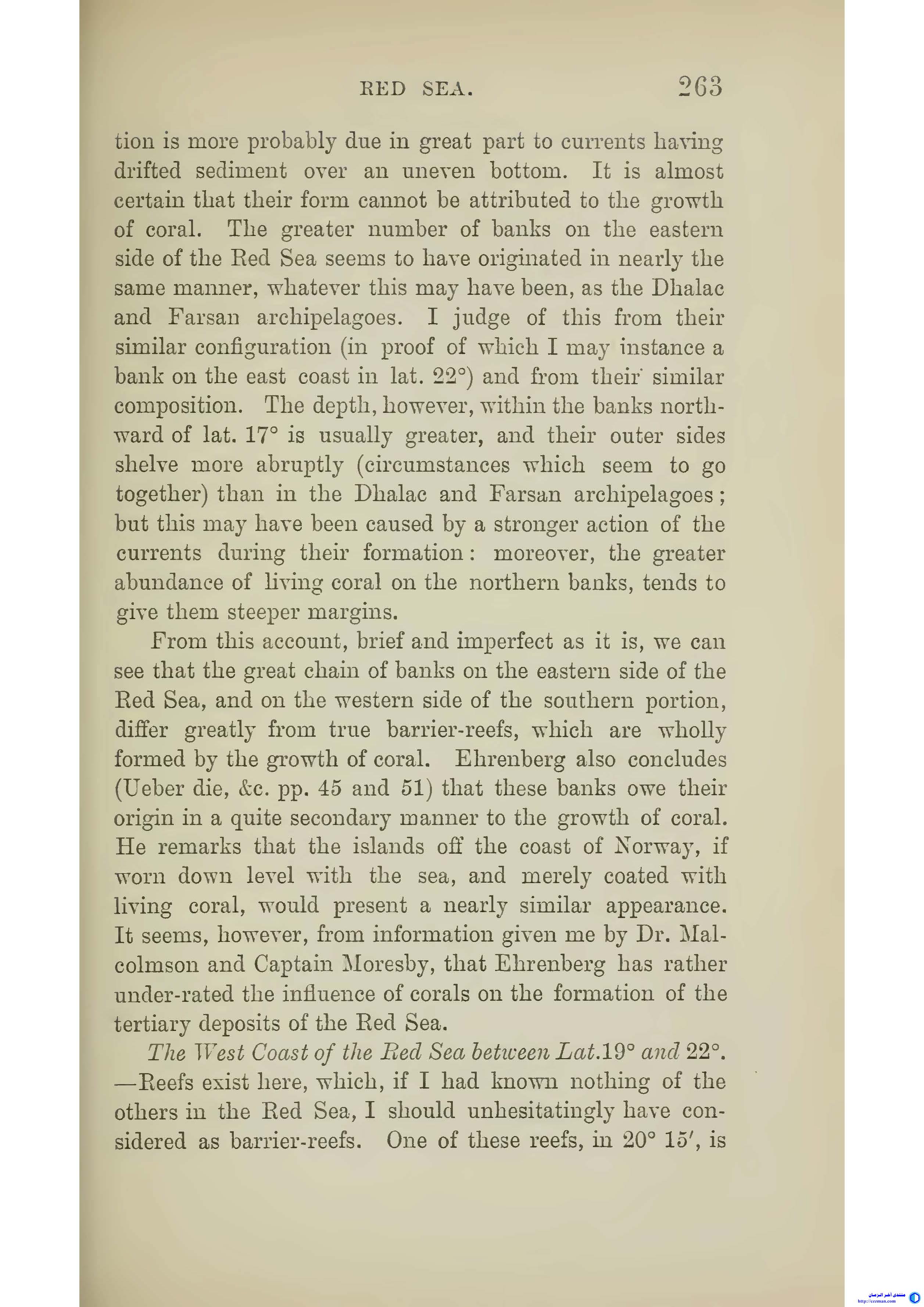
هذه بعض الصفحات الذي ذكرت فيها أٍرخبيل فرسان مع التفريغ النصي لها:
 262 APPENDIX.
262 APPENDIX. western coast, is siuTonncled by an intricate archipelago of
islets and shoals ; the main island is irregular in outline,
and includes a bay seven miles loftg, by four across, in
which no bottom was found with 252 feet ; there is only
one entrance into it, half a mile wide, and with an island
in front. The submerged banks on the eastern coast,
within the same latitudes, round Farsan Island, are, like-
wise, penetrated by many narrow creeks of deep water ;
one is twelve miles long, in the form of a hatchet, and close
to its broad upper end, soundings were not struck with
360 feet ; its entrance is only half a mile wide. In
another creek of the same nature, but even with a more
irregular outline, there was no bottom with 480 feet.^ The
island of Farsan itself, has as singular a form as any of its
surrounding banks. The bottom of the sea round the
Dhalac and Farsan Islands consists chiefly of sand and
agglutinated fragments of coral, but, in the deep and narrow
creeks, it consists of mud ; the islands consist of thin,
horizontally stratified, modern tertiary beds, containing
but little broken coral ; - their shores are fringed by living
coral-reefs.
From the account given by Eiippell ^ of the manner in
which Dhalac is rent by fissures, the opposite sides of
which have been unequally elevated (in one instance to
the amount of 50 feet), it seems probable that this irregular
form, as well as that of Farsan, may have been partly
caused by unequal elevation ; but, considering the general
form of the banks, and of the deep-water creeks, together
with the composition of the land, I think their configura-
* [The islands of this group are of upraised coral, as is the fore-
shore of the opposite coast of Abyssinia. In many parts of the Ked
Sea coast the low coral cliffs give evidence of upheaval. There are,
nevertheless, reefs which would be classed as barrier-reefs on both
sides of the central part of the Ked Sea.— Capt. Wharton.]
- Rlippell, Eeise in Abyssinie, Band. i. s. 247.
3 Ibid. s. 2io
 264 ArrENDix.
264 ArrENDix.
twenty miles long, less than a mile in width (bat expanding at the northern end into a disk), slightly sinuous, and parallel to the main land at the distance of five miles from it, with very deep water inside, so that in one place sound- ings were not obtained with 205 fathoms. Some leagues further south, there is another very narrow reef, ten miles long, with other small portions of reef, north and south, almost connected with it ; and within this line of reefs (as w^ell as outside) the water is profoundly deep. There are also some small linear and sickle-formed reefs, lying a little way out at sea. All these reefs are covered, as I am iiiformed by Captain Moresby, by living corals. Here, then, we have all the characters of reefs of the barrier class, and some of the outlying reefs partially resemble atolls. My only source of doubt arises from the narrowness and straightness of the spits of sand and rock in the Dhalac and Farsan groups ; one of these spits in the former group is nearly fifteen miles long, only two broad, and is bordered on each side with deep water ; so that, if worn down by the surf, and coated with living corals, it would form a reef nearly similar to those within the space under considera- tion. Nevertheless I cannot believe that the many small, isolated, and sickle-formed reefs, as well as others long, nearly straight, and very narrow, with the water unfathom- ably deep close round them, could have been formed by corals merely coating banks of sediment or the abraded surfaces of irregularly shaped islands. It seems more pro- bable that the foundations of these reefs have subsided, and that the corals, during their upward growth, have given to them their present forms. I have, therefore, with much hesitation coloured this part blue. The West Coast, from Lat. 22° to 24°.— This part of the coast (north of the space coloured blue on the map) is fronted by an irregularly shelving bank, from 10 to 30 fathoms deep ; numerous little reefs, some of which have
 RED SEA. 263
RED SEA. 263
tion is more probably due in great part to currents having
drifted sediment over an uneven bottom. It is almost
certain that their form cannot be attributed to the growth
of coral. The greater number of banks on the eastern
side of the Red Sea seems to have originated in nearly the
same manner, whatever this may have been, as the Dhalac
and Farsau archipelagoes. I judge of this from their
similar configuration (in proof of which I may instance a
bank on the east coast in lat. 22"") and from their' similar
composition. The depth, however, within the banks north-
ward of lat. 17° is usually greater, and their outer sides
shelve more abruptly (circumstances which seem to go
together) than in the Dhalac and Farsan archipelagoes ;
but this may have been caused by a stronger action of the
currents during their formation : moreover, the greater
abundance of hving coral on the northern banks, tends to
give them steeper margins.
From this account, brief and imperfect as it is, we can
see that the great chain of banks on the eastern side of the
Eed Sea, and on the western side of the southern portion,
differ greatly from true barrier-reefs, which are wholly
formed by the gi'owth of coral. Ehrenberg also concludes
(Ueber die, &c. pp. 45 and 51) that these banks owe their
origin in a quite secondary manner to the growth of coral.
He remarks that the islands off the coast of Norway, if
worn down level with the sea, and merely coated with
living coral, would present a nearly similar appearance.
It seems, however, from information given me by Dr. Mal-
colmson and Captain Moresby, that Ehrenberg has rather
under-rated the influence of corals on the formation of the
tertiary deposits of the Red Sea.
The West Coast of the Bed Sea heticeen Lat.l9° and 22°.
— Eeefs exist here, which, if I had known nothing of the
others in the Red Sea, I should unhesitatingly have con-
sidered as barrier-reefs. One of these reefs, in 20° 15', is
|